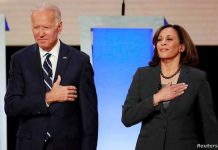North and South Korea have traded hundreds of rounds of live artillery fire across their disputed maritime border, forcing South Korean islanders to take shelter a day after the North drove up tensions by threatening a new nuclear test.
The exchange yesterday, triggered by a three-hour North Korean live-fire exercise that dropped shells into South Korean waters, was limited to untargeted shelling into the sea, military officials said.
South Korea’s defence ministry said the North fired some 500 shells during the drill, around 100 of which landed on the south side of the sea boundary.
Ministry spokesman Kim Min-seok said the South had responded to Pyongyang’s “premeditated provocation” by firing 300 shells from K-9 self-propelled Howitzer batteries based on its frontline islands.
“If the North takes issue with our legitimate returning of fire and uses it to make yet another provocation towards our sea and islands, we will make a resolute retaliation,” said Kim.
Analysts said the incident, coming a day after Pyongyang threatened to conduct a “new form’’ of nuclear test, was largely a sign of the North’s growing frustration with US resistance to resuming multi-party talks on its nuclear program.
“I don’t see that this ran any real risk of escalating into a serious clash,’’ said Yang Moo-jin, a professor at the University of North Korean Studies in Seoul.
“It’s really North Korea showing it intends to keep the pressure on to resume a dialogue,” Yang said.
Pyongyang sees the nuclear negotiations as an opportunity to win material concessions and aid from the international community.
The South Korean stock market shrugged off the incident, with the main Kospi index closing up 0.23 per cent at 1,985.61.
The North had ensured maximum publicity for its live-fire drill by taking the unusual step of notifying the South beforehand, and issuing a provocative no-sail, no-fly advisory.
The exercise began at 12.15pm (1415 AEDT) and South Korea, which had threatened to respond if any shells crossed the border, retaliated shortly afterwards.
“Our military fired back north of the border in line with ordinary protocol,’’ the defence ministry said.
As a precaution, border island residents were evacuated to shelters, as South Korean fighter jets flew overhead.
Kang Myeong-sung, speaking from a shelter on Yeonpyeong island, which is in sight of North Korean territory, said that anxious islanders were huddled together in shelters.
Kang said he didn’t see any fighter jets, but he could hear the boom of artillery fire.
In November 2010, North Korea shelled Yeonpyeong island, killing four people and triggering concerns of a full-scale conflict.
Pyongyang has carried out a series of rocket and short-range missile launches in recent weeks, in a pointed protest at ongoing annual South Korea-US military exercises.
The North calls the South Korea-US drills a rehearsal for invasion; the allies say they’re routine and defensive.
Monday’s incident coincided with nearly 15,000 South Korean and US troops launching a massive, 12-day amphibious landing drill.
Last week, the North upped the ante by test-firing two mid-range ballistic missiles capable of striking Japan.
As well as the annual South Korean-US military drills, the North has been angered by efforts to bring Pyongyang before the UN Security Council over a UN report detailing Pyongyang’s record of systematic human rights abuse.
Joint operation … South Korean (right) and US (left) marines gesture to a point during
Joint operation … South Korean (right) and US (left) marines gesture to a point during a landing operation Pohang. Source: AFP
The Yellow Sea border is an extremely sensitive region that has been the scene of brief but bloody clashes in the past.
In November 2010, North Korea shelled a South Korean island near the border, killing four people and triggering concerns of a full-scale conflict.
Last spring, tension spiked after a near-daily barrage of North Korean threats, including warnings of nuclear strikes against Seoul and Washington, following international criticism of Pyongyang’s third nuclear test in February of last year.
N.Korea fires missiles as U.S., Japan, S.Korea leaders meet 1:28
Play video
http://cdn.newsapi.com.au/image/v1/external?url=http://content6.video.news.com.au/hidjNlbDrSvIz9hJSXYs0WWV-s_ZtvoI/promo220089040&width=650&api_key=kq7wnrk4eun47vz9c5xuj3mc
North Korea fired missiles into the sea, as U.S. President Barack Obama brought together the leaders of South Korea and Japan to discuss how to deal with Pyongyang. Sarah Toms reports.
Autoplay
ON
OFF
It is not unusual for North Korea to carry out a live-fire exercise, but it does not normally notify the South in advance.
“The fact that they have sent such a message to us indicates their hostile intention,” said South Korean Defence Ministry spokesman Wi Yong-Seop.
“The aim is to threaten us and rack up tension on the Yellow Sea border and the overall Korean peninsula,” Wi said, adding that Seoul was closely monitoring the situation.
The move is seen as an expression of Pyongyang’s frustration at making little progress in its recent push to win outside aid.
Two Koreas exchange fire
War games … US Marines take a positon during a joint landing operation by US and South Korean Marines in Pohang. Source: AFP
Lim Eul Chul, a North Korea expert at South Korea’s Kyungnam University, said the North might conduct a fourth nuclear test and launch other provocations to try to wrest the outside concessions it wants.
The Korean Peninsula remains in a technical state of war because the 1950-53 Korean War ended with an armistice, not a peace treaty.
About 28,500 American troops are deployed in South Korea to deter potential aggression from North Korea.




